Pav Bhaji, Mumbai Street-Style Mixed Vegetable Curry
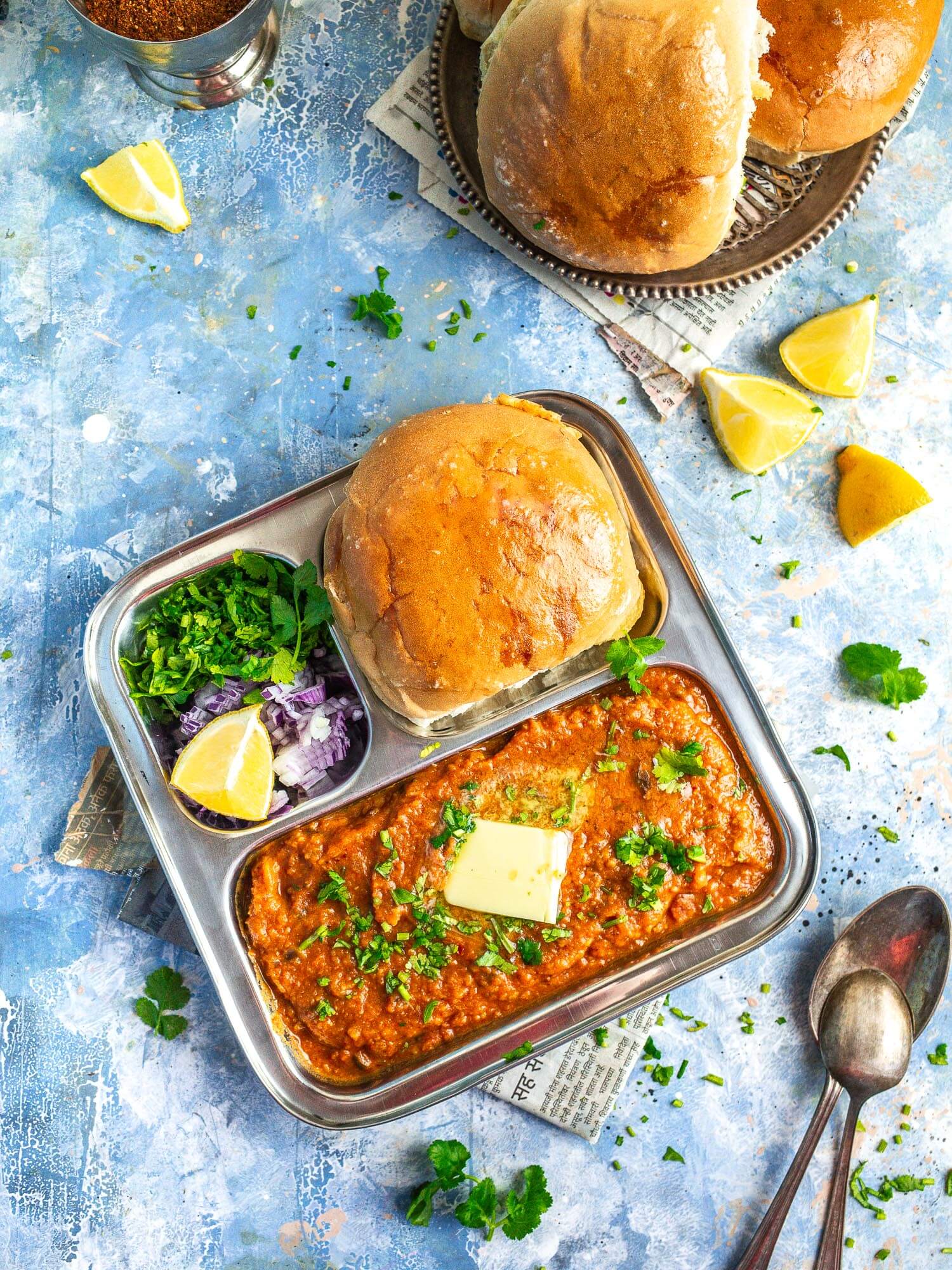
If you haven’t tried pav bhaji yet, you’re missing out! This dish is one of India’s most renowned street foods, and for good reason. Picture a lip-smackingly spicy, tangy, and fiery blend of mashed, mixed vegetables garnished with fresh, zesty coriander, sharp red onions, and a decadent slab of creamy butter. The crowning glory is buttery fried fluffy pav buns, ideal for mopping up all those intense flavors.
Much like other famous Maharashtrian street foods, like vada pav and misal pav, whenever I see the famed dish on a restaurant menu, I always order it. As much as I love more homely dishes like drumstick dal or flower batata rassa (spicy Marathi aloo gobi), there’s just something about street food-style dishes. They’re moreish, irresistible, and indulgent.
Besides, few restaurants in the U.K. offer the dish on the menu. Luckily, making it at home is as simple as just three main steps — it’s ready in less than 30 minutes if you use a pressure cooker, and most of that is hands-off cooking time. Plus, since it’s homemade, it’s far healthier … without sacrificing the distinctive taste. Want to know how to make it? Let’s dive in!
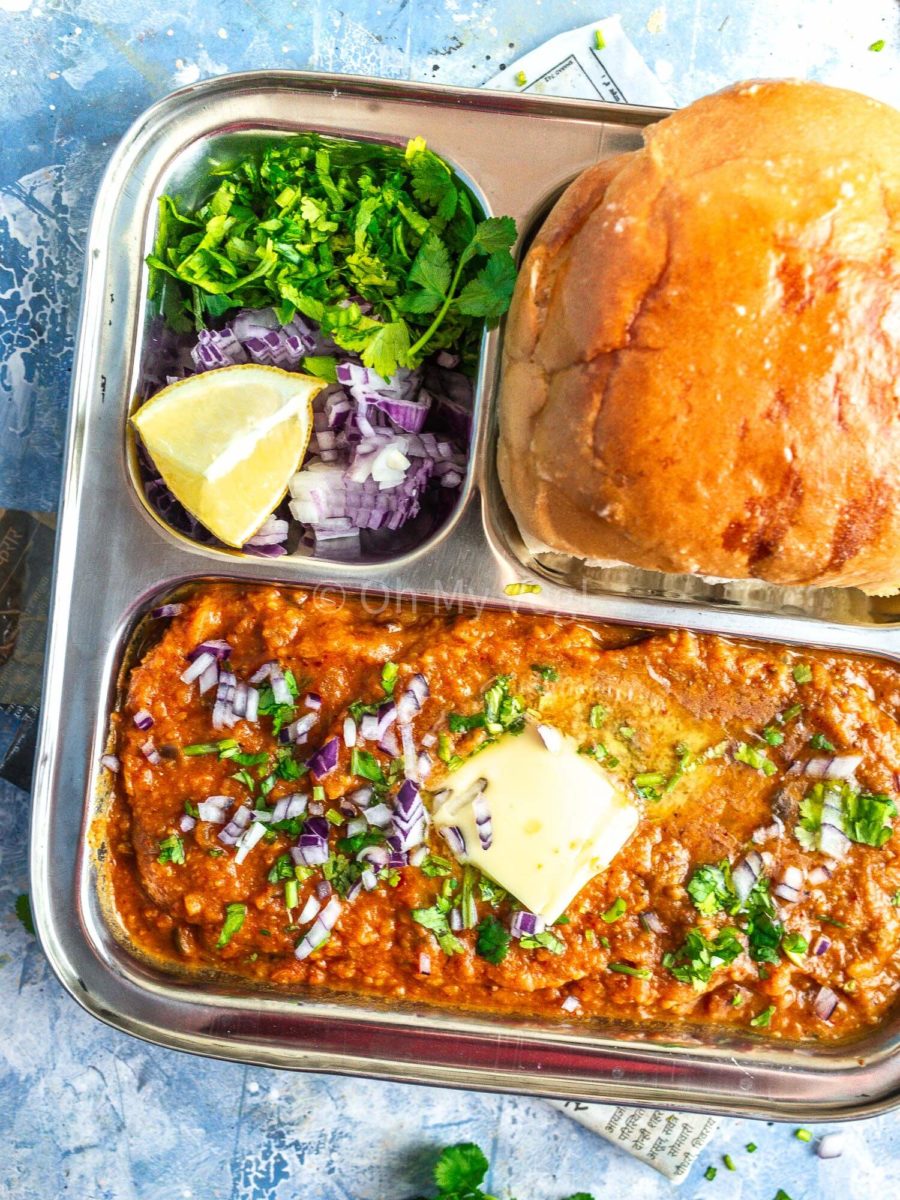
What is Pav Bhaji?
The beloved pav bhaji, an iconic Indian street food, is a quintessential part of Maharashtrian cuisine, offering a quick and hearty option, particularly for busy office workers.
Although we think of pav bhaji as a modern street food, the origins of the dish date back to the late 1800s. Let’s get into the history! Before the American Civil War in 1861, the United States, producing over two-thirds of the world’s cotton, supplied it to Britain, where around 16% of the population depended on the cotton trade for their livelihoods.
The U.S. Southern Confederates — those who wanted to continue slavery — stopped shipping cotton to the U.K. in the hope that the country, which was a world power, would be forced to recognize its legitimacy. Britain, which had abolished the slave trade over half a century earlier in 1807, declined. However, in need of cotton, the U.K. looked to India to fill the void left by American imports, placing immense strain on Mumbai, the center of the cotton mills.
As the pressure on Mumbai textile workers mounted, they found themselves working through the night, with neither their wives nor street vendors available to provide them with food. Soon, though, a solution was found: a thick curry using leftover vegetables from the day before with fluffy bread to provide extra energy.
Nobody knows exactly who invented this iconic street-food dish, although it was likely one of the textile workers’ wives’ stroke of genius we can thank for the legendary dish today. In the modern day, pav bhaji is still enjoyed as a quick lunch on the go, although it’s also served at home and in restaurants across India and elsewhere.
What is Pav and What is Bhaji?
If you’re unfamiliar with Marathi, you may wonder what is the “pav” in pav bhaji. Pav is a fluffy milk bread in a roll or bap shape. During Portuguese colonization in the Konkan area, they brought the bread to Maharashtra. The name derives from Portuguese (“pão,” meaning bread). Interestingly, pao also means “a quarter” in Hindi.
“Bhaji” in Marathi translates to fresh vegetables or a dry vegetable-based curry. In this case, it’s the latter!
Don’t confuse bhaji with pakora or onion / kanda bhaje, which is often spelt “bhaji” in the U.K. Bhaji is pronounced bah-jee whereas bhaje (Maharashtrian-style pakora) is pronounced buh-jay.
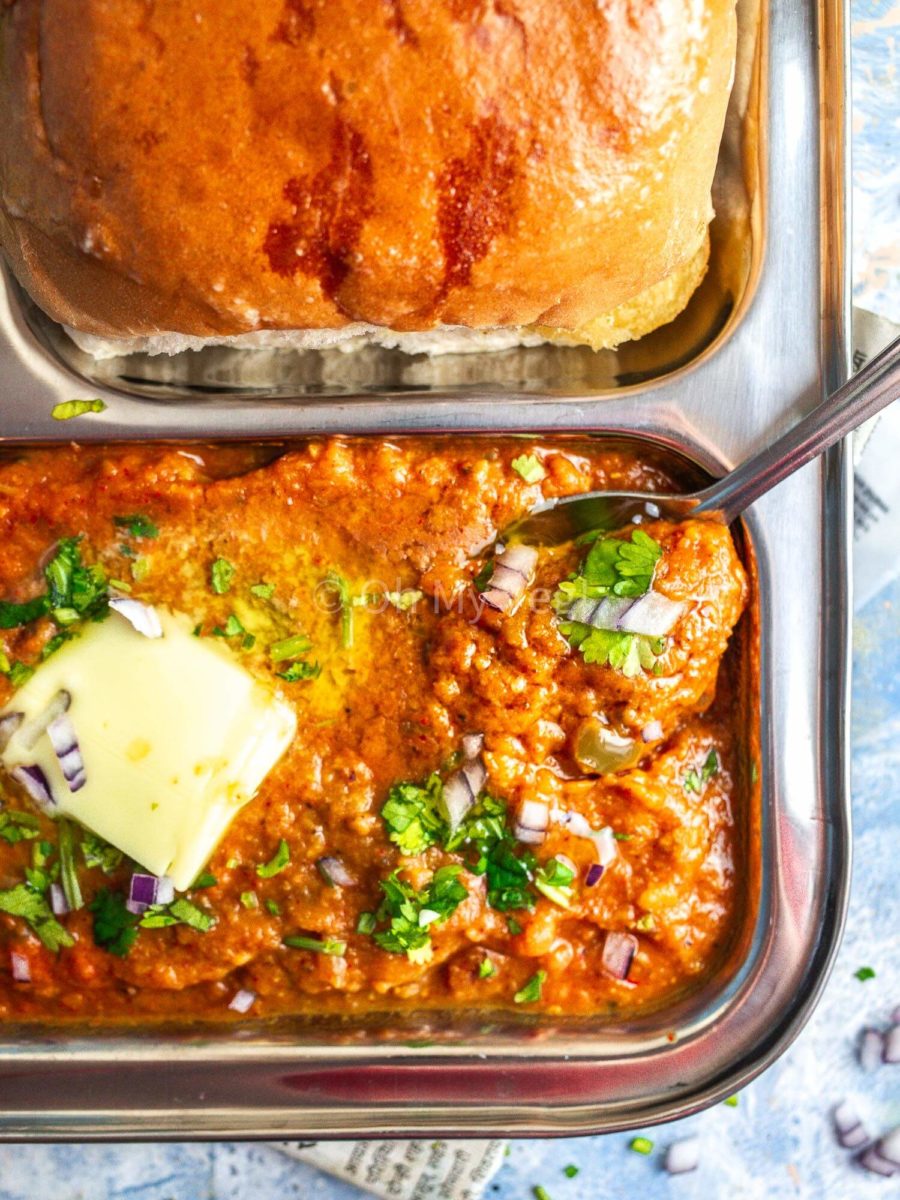
What is Pav Bhaji Made Of?
Contrary to the reputation of Indian recipes with exhaustive and complex ingredient lists, this street-style pav bhaji breaks that stereotype. You need a few staple vegetables, one or two essential spices, and pav bhaji masala — that’s it!
For the specific ingredient quantities needed for this recipe, see the recipe card.
Pav Bhaji Ingredients
- Vegetables like potatoes, cauliflower, carrots, tomatoes, and green peas are common ingredients in this Marathi street food. Potatoes form the bulk of the curry, adding body to the sauce and a deliciously mellow, creamy flavor. Mumbai street-style pav bhaji has a higher ratio of potatoes, so I’ve mimicked that — but adding cauliflower contributes nuttiness, carrots a natural sweetness, peas a bright freshness, and tomatoes provide acidity.
- Butter is rich and creamy, the perfect fat for a street-style recipe. I use vegan butter to make this recipe plant-based, but you can use oil or, if you’re not vegan, dairy butter.
- Onion provides natural sweetness to the curry.
- Green capsicum fried in butter is essential. The vegetable has a mild, crisp sweetness brighter than its red or yellow counterparts.
- Ginger garlic paste builds depth of flavor. I like using homemade ginger-ginger paste since storebought often has an unpleasant aftertaste.
- Pav bhaji masala is a spice blend full of aromatic and fiery notes. It gives the Maharastrian recipe its distinctive flavor.
- Chili powder not only adds fruity heat to the Mumbai street-style pav bhaji but also adds to the characteristic bright red flavor. I love to use the vibrant deggi mirch for this reason!
- Turmeric powder isn’t a component of traditional pav bhaji masala, so we add some for earthiness.
- Salt helps to bring out all the other flavors.
- Lemon juice adds zesty sourness to the curry, helping to mellow the spice and blend more layers.
- Fresh coriander is a must-add garnish, complementing the citrusy element.
- Pav, or Indian bread rolls, are ideal for mopping up the thick mixed vegetable curry! You can eat pav bhaji with roti, but I highly recommend getting ahold of some fluffy rolls/baps.
Ingredient Spotlight
Pav bhaji masala is an essential ingredient in street-style pav bhaji. But what it is, where can you buy it, and which pav bhaji masala is best?
Well, pav bhaji masala is a blend of whole spices which are ground to a fine powder, like garam masala or chaat masala. You should be able to find it at your local Indian store, or failing that, at an online retailer like this pav bhaji masala from Amazon.
You can also easily whip up some homemade pav bhaji masala, but if you don’t have a fully-stocked pantry of whole spices, it’s better to just go ahead and buy it.
Pav Bhaji Allergens
I strive to cater to various dietary preferences in my recipes! Plus, I always provide possible adaptations or substitutions if the original recipe isn’t suitable for religious or culinary requirements. Here are my notes on pav bhaji:
- Is pav bhaji vegetarian? Yup! All pav bhaji recipes should be vegetarian by default, like most Indian recipes. All the recipes on Oh My Veg are vegetarian!
- Is pav bhaji vegan? Typically, pav has milk and butter, and the bhaji uses dairy-based butter, making it not vegan-friendly. However, I make my version vegan by using vegan butter in the recipe (U.K. readers, I love Flora Salted Plant Butter; U.S. readers, try Miyoko’s European Style Cultured Butter) and vegan bread rolls.
- Is pav bhaji nut-free? Yes, it’s nut-free, making it suitable for those with nut allergies!
Unfortunately, this dish isn’t gluten-free. However, since the only issue is the pav (usually wheat-based), you can swap it out with gluten-free bread rolls. These are generally easy enough to find at your local supermarket.
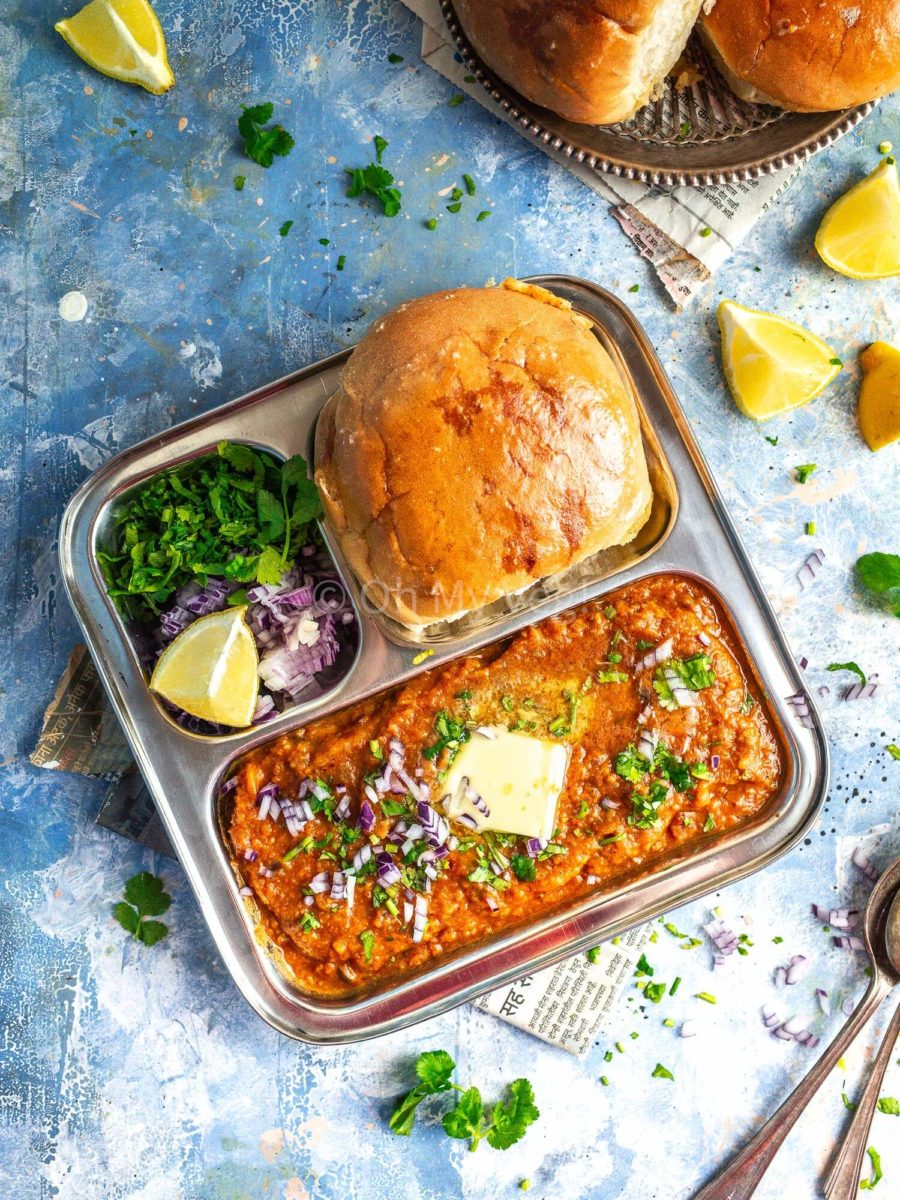
How Pav Bhaji is Made
You won’t believe how easy it is to make this dish like your favorite street food vendor (or restaurant!) I’ve broken the process into simple steps so you can get associated with the method before following the complete instructions with timing down in the recipe card.
Honestly, there are extraordinarily few recipes with such little work and such a HUGE flavor pay-off. I have a mammoth collection of 30-minute recipes, but this Mumbai pav bhaji might be the most low-effort.
- Boil the vegetables along with water until they break down completely. Mash them.
- Start making the curry by frying onions, homemade garlic ginger paste, green capsicum, and powdered spices. Add the mashed vegetables to the pan, season with salt, and add water.
- Simmer the curry until it thickens and season with lemon juice.
- Garnish with plenty of fresh coriander, chopped red onions, and a healthy chunk of butter.
- Heat the pav in butter until lightly toasted, and serve alongside your Mumbai street-style pav bhaji.
Pav bhaji is also ideally suited for making in a slow cooker or pressure cooker, for extra busy days!
Variations for This Dish
This straightforward, Mumbai street-style pav bhaji is my favorite variation. For years, traditional pav bhaji has been part of my regular meal rotation! But, if you master this recipe and feel like experimenting, there’s a surprising number of ways you can spice this dish up:
- Pav bhaji with cheese in a variation you’ll see all over Mumbai! All you need to do to make this street food classic is add grated cheese (homemade paneer is my go-to choice here, although any mild and meltable cheese will work). You can also use vegan cheese to keep this recipe plant-based!
- Pav bhaji with cabbage is another way of adding more vegetables to this vegan version of a street-food classic recipe. Use green cabbage and chop it very finely since it doesn’t mash like the other veggies.
- Pav bhaji with sweet potato is a unique twist on the Mumbai-style platter. Sweet potatoes have a lower glycemic index and boast high vitamin A levels. Entirely replace the white potatoes with sweet potatoes, or swap out half.
- Pav bhaji with roti is a lighter version. Can’t find vegan bread rolls? Pav bahji with roti is a great alternative. Pav bahji also tastes fantastic with plain white sandwich bread.
- Pav bhaji without onion and garlic is a Jain-friendly version. Just omit both from this recipe and add asafoetida (hing) instead.
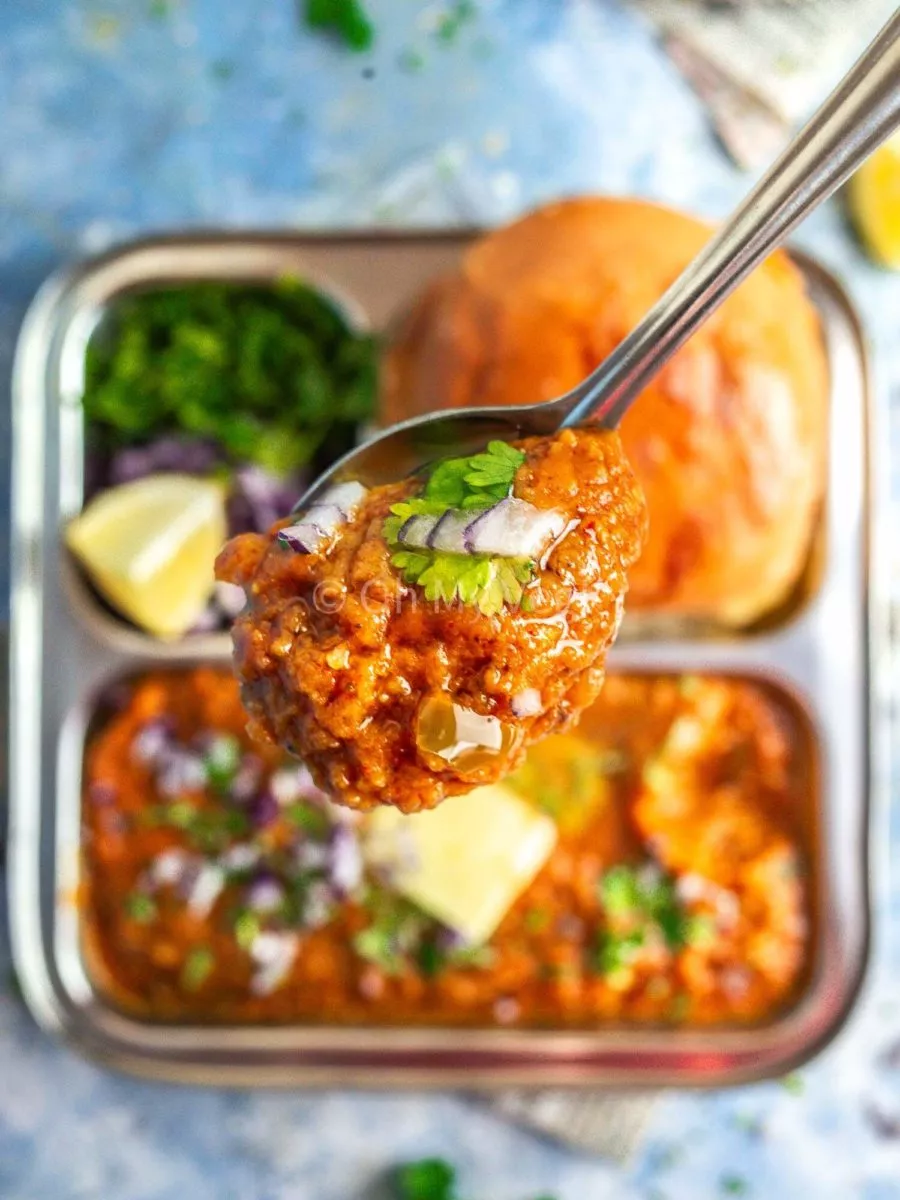
Can Pav Bhaji be Frozen?
Indeed, it can be frozen! Although most Indian recipes freeze well, this one is particularly well-suited for freezing.
While I don’t often have leftovers, you can store this meal in an airtight container for around three days in the refrigerator.
If you want to freeze the curry, I recommend bulk-cooking multiple portions and freezing it to enjoy throughout the coming months. Portion the gravy, place it in freezer-safe containers and freeze for up to two months.
You can use the microwave, stovetop, or oven to defrost the dish — whichever suits your convenience. Because it’s a mashed vegetable curry, there’s less worry of preserving texture here. I usually opt for the microwave or oven. Refresh the curry with fresh coriander, lemon juice, chopped red onions, and butter.
This Recipe Is …
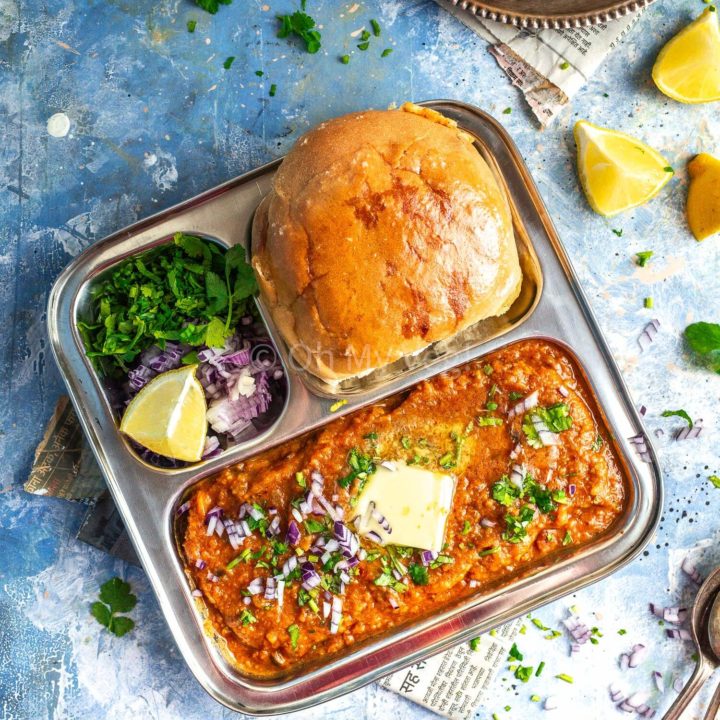
Pav Bhaji - Maharashtrian Mashed Mixed Vegetable Curry
This easy, authentic pav bhaji is a spicy mashed vegetable curry served with buttery-fried fluffy pav buns. Ready in less than 30 mins!
Ingredients
For the Mashed Vegetables:
- 220g Potatoes, chopped into medium sized pieces
- 40g Cauliflower, chopped into medium sized pieces
- 60g Carrots, cut into small rounds
- 200g Tomatoes, roughly quartered
- 40g Green Peas*
- 600ml Water
For the Bhaji:
- 5 tbsp Vegan Butter****
- 100g Onion, finely chopped (1 large)
- 80g Green Bell Pepper, finely chopped
- 1 tsp Ginger-Garlic Paste
- 2 tbsp Pav Bhaji Masala
- 1.5 tsp Deggi Mirch**
- 1.5 tsp Chili Powder (Hot Maharashtrian chilis)**
- 1/4 tsp Turmeric
- Sea Salt, to taste
- 2 tsp Lemon Juice
- Fresh Coriander (Cilantro), to garnish
- Finely chopped Red Onion, to garnish
- Vegan butter, to taste
For the Pav:
- 3 Vegan Bread Rolls each – or to taste
- 1 tbsp Vegan butter
Instructions
- Boil the vegetables. Add all the vegetables and water in the first section to a pressure cooker. Cook on medium heat for around three whistles***, until they break down completely. Mash them.
- Start making the curry. Over medium flame, heat butter in a large kadai or non-stick, deep-sided frying pan. Once melted, add the onions and homemade garlic ginger paste, sauté for a few seconds, then add the green capsicum. Cook for one minute, stirring. Then add the powdered spices and pav bhaji masala. Mix well, then add the mashed vegetables, and season with salt. You shouldn't need to add water.
- Simmer the curry until it thickens. If your curry is already thick, then skip this step! Season with fresh lemon juice to taste.
- Garnish the pav bhaji with plenty of fresh coriander, chopped red onions, and a healthy chunk of vegan butter.
- Cook the pav in butter over low heat until lightly toasted, and serve alongside your Mumbai street-style pav bhaji.
Notes
* I use frozen green peas, but if you have fresh ones, that's also fine.
** This is a very spicy dish – adjust to your tastes. I use a mixture of hot Chilli Powder made from Maharashtrian chilis for the spiciness, and Deggi Mirch or Kashmiri Chilli Powder for the color.
*** If you don't have a pressure cooker, use a large saucepan with a lid and cook for around 20 minutes, until the vegetables are completely soft.
**** If you don't want to use or don't have access to vegan butter, replace it with neutral oil or dairy-based butter.
Recommended Products
As an Amazon Associate and member of other affiliate programs, I earn from qualifying purchases.
Nutrition Information:
Yield: 4 Serving Size: 1Amount Per Serving: Calories: 367Total Fat: 29gSaturated Fat: 8gTrans Fat: 1gUnsaturated Fat: 20gCholesterol: 22mgSodium: 298mgCarbohydrates: 25gFiber: 5gSugar: 7gProtein: 4g
Nutrition information isn’t always accurate.


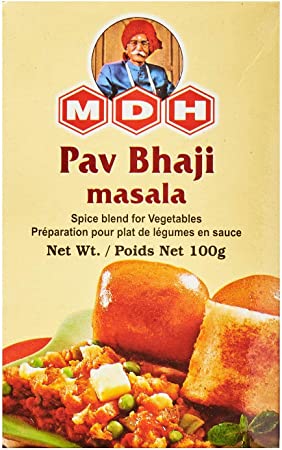
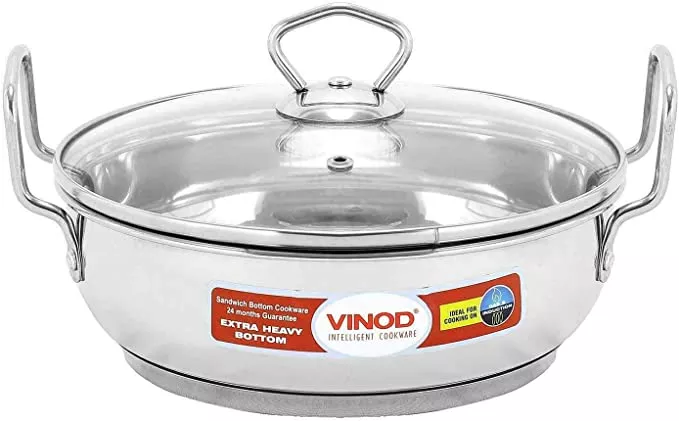
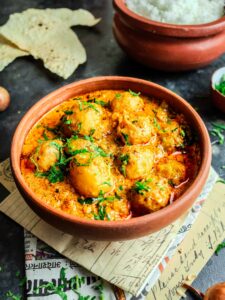
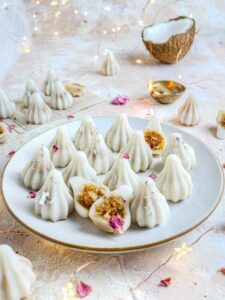
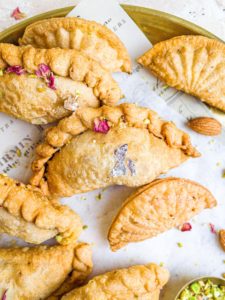
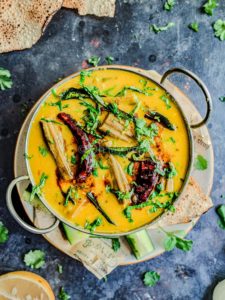
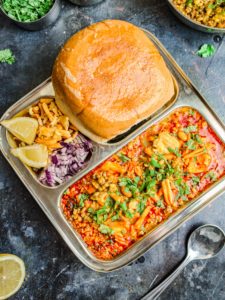
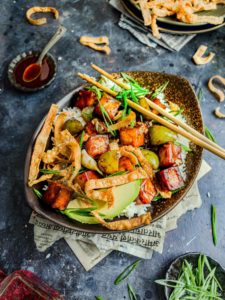
2 Comments